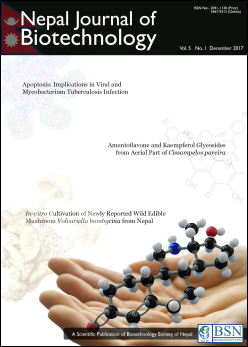Assessment of Quality of Underground Drinking Water: Very near (≤20 meters) and Far (>50 meters) from the River
DOI:
https://doi.org/10.3126/njb.v5i1.18866Keywords:
Bacteriological quality, Biological, drinking water, Fecal Coliform, Ground water, PhysiochemicalAbstract
Water quality information is needed to assess the state of water contamination in a variety of community, including those that rely primarily on unimproved underground sources of drinking water. The study was carried out with an aim to assess the quality of ground water in particular sites of the Kathmandu valley. The ground water samples were collected from shallow well, tube well and deep tube wells located at specific places of the valley. The research was focused on physiochemical and bacteriological analysis of underground water from sites near to Bagmati river (≤20 meters) and from sites far from Bagmati river (>50 meters). The sampling sites were scattered from Sinamangal to Minbhavan. Total sample size was 100, with 50 in each stratum. Study processing was done during the period from February 2013 to May 2013. Six physiochemical parameters namely pH, Conductivity, Ammonia level, Chloride level, Nitrite level, Nitrate level and Biological parameters (Coliform and Fecal coliform) of each sample was tested. Based on the research work, it was recorded that the underground water close to river (≤20 meters) has comparatively high physiochemical and biological parameter (Fecal Coliform) than underground water that were farther from the river (>50 meters). Fecal Coliform was predominant 58% (29/50) in water nearer to river rather than in water farther from the river 20% i.e. (10/50). Similarly, the values of physiochemical and biological parameter increased comparatively with more distance i.e. ≤10 meters from river. The finding indicated that the underground water near to river is more polluted than far from the river.
Nepal Journal of Biotechnology. Dec. 2017 Vol. 5, No. 1:21-26
Downloads
Downloads
Published
How to Cite
Issue
Section
License
Copyright Notice:
The manuscript submitted to NJB must be an original contribution, not previously published and should not be under consideration for publication elsewhere. When the manuscript is accepted for publication, the authors agree to automatically transfer the copyright of the article to the publisher. It should grant permission to any third party, in advance and in perpetuity, the right to use, reproduce or disseminate your article, according to the NJB copyright and license agreement.
Authors transfer copyright to the publisher as part of a journal publishing agreement but have the rights to: Share their article for Personal Use, Internal Institutional Use and Scholarly Sharing purposes, with the NJB applies the Creative Commons Attribution-NonCommercial CC BY-NC license to all the works we publish after Jun 2020 (Before it was CC BY-NC-ND). Under this license, authors agree to make articles legally available for reuse, without permission or fees, for virtually any non-commercial purpose. Anyone may remix, adapt, and build upon your work non-commercially, and although their new works must also acknowledge you and be non-commercial, they don’t have to license their derivative works on the same terms. More details on CC BY-NC refer to its Licence Deed and Legal Code.






